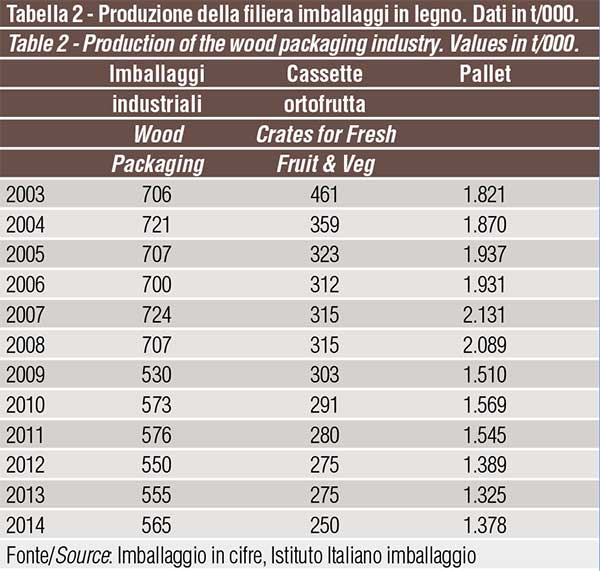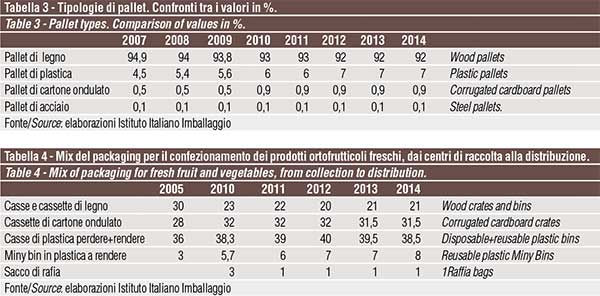When packaging is wood
Wood packaging is a fundamental tool in the handling of goods in various manufacturing sectors
After a two-year recession, 2014 was the year of recovery for the packaging sector. The trend also included wood packaging, whose production reached 2,193 t/000, with 1.3% growth.
This positive result included both domestic demand and exports.
The generic term “wood packaging” refers to various container types: industrial packaging, pallets, crates for fresh fruit and vegetables, but also barrels and corks.
Italian wood packaging manufacturers, including material suppliers, number approximately 2,329: 67% of operators are in Northern Italy, 13.5% in the Center and 19.5% in Southern Italy and the islands (Sardinia and Sicily).
12% of concerns are specialized in the production of crates and bins for fresh fruit and vegetables; about 49% are pallet manufacturers (including repair services) and 39% are industrial packaging manufacturers.
Suppliers of raw materials destined for the production of wood packaging and importers of empty packaging also operate in the sector.

Pallets, industrial packaging
and crates
Wood packaging, as surveyed by Istituto Italiano Imballaggio, can be divided into three types: pallets, industrial packaging and crates for fresh fruit and vegetables. The first category has a vast array of application sectors; more than 75% of the second category, industrial packaging, is used in mechanics, electrical engineering and spare parts, while the remaining 25% concerns a broad product category (reels for tubing transport, cable reels, various boxes for wines and spirits, cork stoppers, etc.).
As for crates for fresh fruit and vegetables, 90% are used for fresh fruit and vegetables, and the remaining 10% is destined for fish.
The wood used to make packaging must be mechanically resistant (that is, they must guarantee the strength with which the wood resists deformation or separation of structural components).
In short, the wood must be compressible, elastic and resistant to cutting; in the field of packaging, the most common woods are poplar, beech, fir, pine, birch and, to a lesser degree, larch, alder and chestnut.

Numbers of the sector
In 2014, wood packaging had an overall turnover of 1,605 million euro (+1% over the previous year).
Total production was 2,193 t/000 (+1.8%).
Both exports (+8.7%) and imports grew, and following a two-year recession, domestic consumption also showed a 3% recovery.
Industrial packaging
Overall, the sector showed a production of 565 t/000 in 2014 (+1.8% over the previous year). Foreign trade was modest, limited to crates for spirits and cork stoppers. The main area of the industrial packaging segment, with a share of about 80%, is represented by large format crates for transporting machinery or components. In some cases, shipping containers are an alternative to wood industrial packaging.
The remainder of about 20% consists in staves, crates for spirits and cable reels. 70-75% of the offer is accounted for by specialist manufacturers working for multiple customers, while the remaining 25-30% has to do with in-house production or concerns that work exclusively for a single customer.
Industrial packaging, in the wider context of wood packaging, represents a specialized management system, and its particular characteristics have to do with sector operators’ desire to manage product distribution services in specially designed containers.
Pallets
The pallet is the most widely used transport packaging by sector. In terms of material and target Italian market, pallets can be divided into four categories: wood pallets (90%); plastic pallets (9%), with a slight growth trend; cardboard pallets (1%) and metal pallets (0.1%), used for internal handling in heavy industry.
In 2014, the production of pallets grew by 4%, following a progressive decline lasting three years (2011-2013), caused by falling exports and domestic demand. The positive growth trend in 2014 was driven both by domestic demand and by exports (but imports also showed some growth).
The progressive substitution of disposable pallets with reusable ones continues, as demonstrated by the spread of pallet renting, with a consequent increase in the number of custom products.

Crates for fresh fruit and vegetables
Handling fresh fruit and vegetables essentially involves two wood packaging types: bins and crates.
The former are used to transport goods from the field to the warehouse, while crates are used for shipping from the warehouse to retailers (supermarkets, open air markets, etc.).
Officially, wood crates are all “disposable”, but, in practice, unofficial “reusable” ones exist, which, according to some fresh fruit and vegetables sector operators, can be estimated at around 3-5% of the total.
The production of wood crates in 2014 was 250 t/000: the -9% decline compared to 2013 was mainly driven by falling domestic consumption of fresh fruit and vegetables generally, in particular those purchased at open-air markets, where the crate predominates over other packaging types.
In recent years, wood crates have considerably improved their appearance, to the point of playing a role in communication. Although their market position has progressively been reduced over the years, the trend appears to be oriented toward generally stabilizing.
Plinio Iascone
Istituto Italiano Imballaggio




















